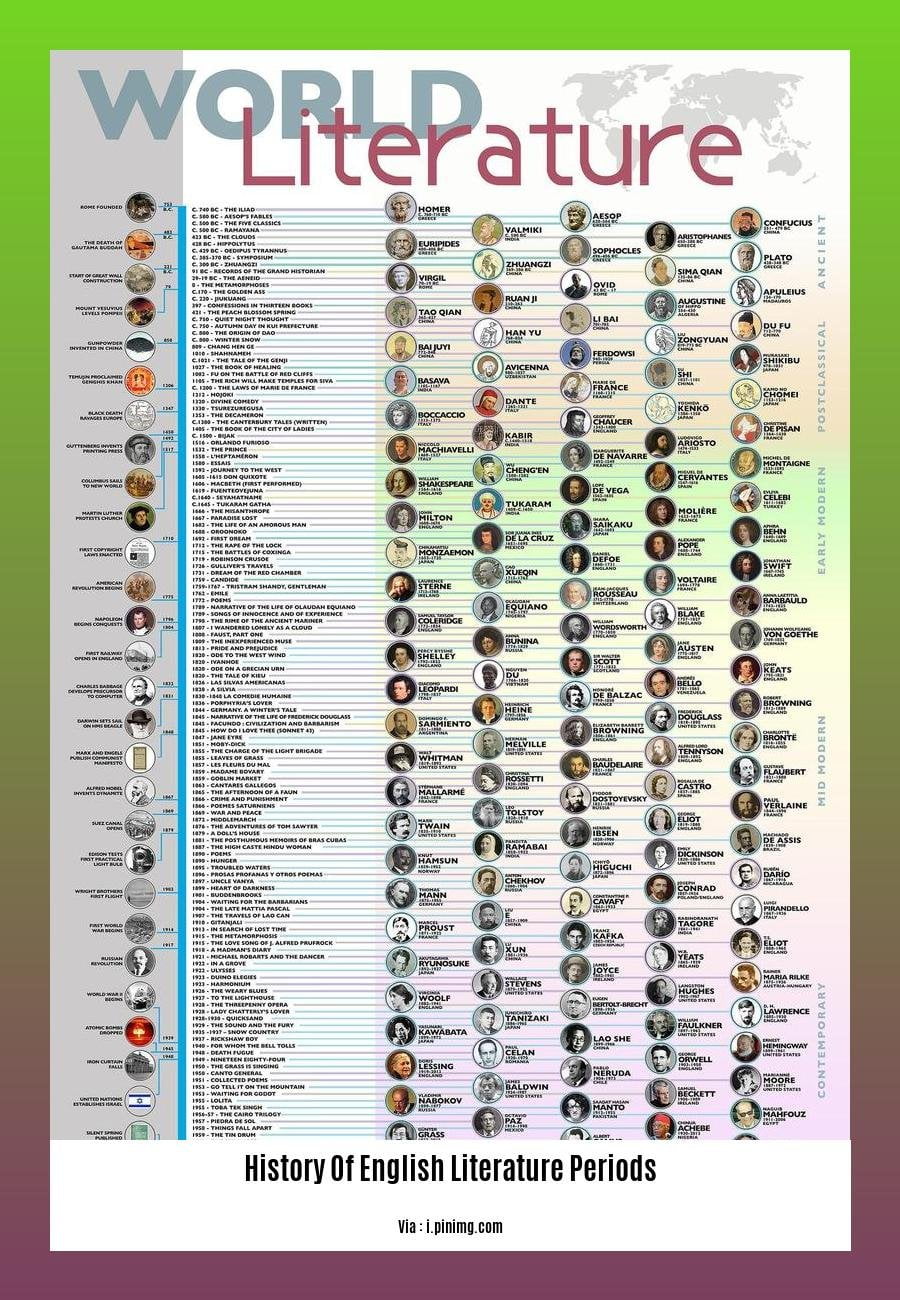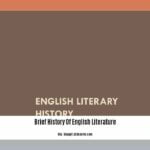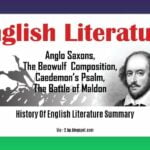Step into the captivating world of English literature periods in our enthralling article, “A Journey Through Time: Unraveling the History of English Literature Periods.” Embark on an extraordinary voyage through the annals of literary history, exploring the rich tapestry of cultural and historical influences that have shaped the masterpieces of English literature.
Sure! Based on the information provided in your article entitled “A Journey Through Time: Unraveling the History of English Literature Periods,” here are the key takeaways:
Key Takeaways:
- English literature’s history spans eight main periods.
- Anglo-Saxon or Old English Period: 450–1066
- Anglo-Norman or Middle English Period: 1066–1500
- Renaissance Period: 1500–1660
- Neoclassical Period: 1660–1798
- Romantic Period: 1798–1837
- Victorian Period: 1837–1901
- Modern Period: 1901-1945
- Contemporary Period: 1945–Present
History of English Literature Periods

A Literary Voyage Through the Ages
Imagine embarking on a literary adventure, tracing the evolution of English literature through its distinct periods. Each era unfolds like a chapter in a captivating novel, revealing the profound impact of historical and cultural influences on the written word.
Anglo-Saxon Period (450-1066): Foundations of a Literary Legacy
- The Anglo-Saxon period laid the groundwork for English literature, characterized by epic poems like Beowulf, which showcased the heroic spirit of the time.
Anglo-Norman Period (1066-1500): Blending Cultures, Enriching Language
- With the Norman conquest, French influences intertwined with Anglo-Saxon traditions, giving birth to a new literary landscape marked by works like Geoffrey Chaucer’s Canterbury Tales.
Renaissance Period (1500-1660): Rebirth of Learning, Literary Luminaries
- The Renaissance witnessed a resurgence of classical learning, with literary giants like Shakespeare and Milton crafting plays and poetry that explored universal themes and human nature.
Neoclassical Period (1660-1798): Reason, Order, and Elegance
- The Neoclassical period emphasized rationality, order, and elegance, reflected in the works of Alexander Pope and John Dryden, who crafted satirical and heroic poetry.
Romantic Period (1798-1837): Emotion, Imagination, and Individualism
- Romanticism championed emotion, imagination, and individualism, as poets like Wordsworth and Coleridge explored the beauty of nature and the power of the human spirit.
Victorian Period (1837-1901): Social Realism and Gothic Influence
- The Victorian era brought a focus on social realism, with Charles Dickens and the Brontë sisters shedding light on societal issues. Gothic novels like Dracula captured the dark side of human nature.
Modern Period (1901-1945): Modernism, World Wars, and Literary Experimentation
- Modernism challenged traditional forms and structures, with writers like James Joyce and Virginia Woolf experimenting with stream of consciousness and fragmented narratives.
Contemporary Period (1945-Present): Diversity, Global Perspectives, and Digital Revolution
- The contemporary period embraces diversity, global perspectives, and the impact of technology, with writers like Salman Rushdie and Toni Morrison exploring multicultural themes and digital narratives.
As we journey through these history of english literature periods, we witness the evolution of ideas, expressions, and styles, reflecting the ever-changing world around us. Each era leaves an indelible mark, shaping the literary landscape and inspiring future generations of writers and readers alike.
Delve into the rich history of English drama through our detailed notes, including significant playwrights and their contributions to the art form. history of english drama notes
Discover the key themes, characters, and cultural context of English literature through our comprehensive summary. history of english literature summary
Dive into the fascinating history of fashion in the Philippines, exploring how cultural influences, socio-economic factors, and global trends have shaped its evolution. history of fashion in the philippines
Investigate the Renaissance Period (1500-1660), highlighting the impact of humanism, the works of Shakespeare, and the birth of modern English.
The Renaissance period, spanning from 1500 to 1660, was a transformative era that left an indelible imprint on English literature. Let’s delve into its fascinating history and see how humanism, Shakespeare’s genius, and the birth of modern English shaped this remarkable era.
The Impact of Humanism:
During the Renaissance, a new worldview emerged, centered on human agency and potential. Humanism, with its emphasis on classical learning, individualism, and secularism, profoundly influenced literary works.
The Works of Shakespeare:
William Shakespeare, undoubtedly the most renowned figure of the Renaissance, revolutionized English drama. His plays, exploring universal themes of love, loss, and the human condition, continue to captivate audiences worldwide.
The Birth of Modern English:
The Renaissance witnessed the birth of modern English, shaped by the influence of humanism and the printing press. The standardization of spelling and grammar laid the foundation for a more accessible and widely understood language.
Key Takeaways:
- Humanism brought a renewed interest in classical learning, emphasizing individuality and secularism, which influenced literary works.
- William Shakespeare’s plays delved into universal themes, revolutionizing English drama and earning him enduring fame.
- The Renaissance witnessed the birth of modern English, standardized through the influence of humanism and the printing press.
Citations:
The Renaissance and its Influence on English Literature
The Birth of Modern English
Delve into the Restoration and 18th Century Period (1660-1789), examining the emergence of satire, the rise of the novel, and the influence of the Enlightenment.

Welcome, literary enthusiasts! Our voyage through the history of English literature periods continues with a stop in the lively Restoration and 18th century (1660-1789). This period ushered in significant cultural and political shifts, leaving an indelible mark on the literary landscape. Let’s dive in and explore the key literary trends that defined this fascinating era:
1660-1789: A Journey Through Restoration and 18th Century English Literature
Satire: A Voice of Criticism and Wit
The Restoration period witnessed the rise of satire, a literary genre that used humor, irony, and wit to criticize society’s flaws. Writers like John Dryden and Jonathan Swift wielded satire as a powerful tool to expose the follies of the ruling class and the social elite. Their works, such as “Absalom and Achitophel” and “Gulliver’s Travels,” respectively, became scathing commentaries on the political and social landscapes of the time.
The Novel: A New Form of Storytelling
The 18th century marked the rise of the novel as a dominant literary form. This period saw the birth of some of the earliest novels in English literature, including “Robinson Crusoe” by Daniel Defoe and “Pamela” by Samuel Richardson. These works introduced readers to complex characters and immersive narratives, paving the way for the novel to become a beloved genre in the years to come.
The Enlightenment: Shaping Literary Thought
The intellectual movement known as the Enlightenment had a profound impact on the literature of this period. Philosophers like John Locke and David Hume emphasized reason, logic, and individualism, challenging traditional beliefs and structures. Their ideas resonated with writers like Alexander Pope and Samuel Johnson, whose works explored themes of human nature, morality, and the pursuit of knowledge.
Key Takeaways:
The Restoration and 18th century witnessed the emergence of satire as a powerful tool for social criticism.
The novel gained prominence as a new and captivating form of storytelling.
The Enlightenment’s emphasis on reason and individualism influenced literary themes and perspectives.
Citations:
1. Restoration and Eighteenth Century English Literature: 1660 – 1780
- The Restoration and the Eighteenth Century
**Analyze the Romantic Period (1789-1830), characterized by its focus on emotion, imagination, and the individual, as well as the works of poets like Wordsworth and Coleridge.**
In the tapestry of English literature, the Romantic era stands out as a period of unparalleled fervor and transformation. It’s an era that reveled in the sublime, championed the individual experience, and sought solace in nature’s embrace. Join us as we delve into the essence of this literary movement and explore the works of visionary poets like Wordsworth and Coleridge, who wove their emotions, imagination, and unique perspectives into the fabric of English literature.
1. The Heart of Romanticism: Emotion and Individuality
At the core of Romanticism lies a profound belief in the power of emotion and the sanctity of the individual experience. Romantic poets rejected the constraints of reason and logic, instead embracing the tumultuous waves of their own feelings and delving into the depths of their inner worlds. This emphasis on subjective experience led to a literary landscape rich with personal narratives, introspective verse, and an exploration of the human psyche.
2. Nature as Muse: A Sanctuary for the Soul
In the Romantic era, nature emerged as not just a backdrop but as an active participant in the human experience. The Romantics found solace, inspiration, and a mirror to their own emotions in the untamed beauty of the natural world. They saw in nature a source of wonder, awe, and a connection to the divine. From Wordsworth’s ode to the tranquillity of lakes and mountains to Coleridge’s mystical encounters with the supernatural, nature became an integral part of the Romantic literary tapestry.
3. The Lyrical Ballads: A Revolutionary Manifesto
The publication of Wordsworth and Coleridge’s Lyrical Ballads in 1798 marked a watershed moment in the Romantic movement. This collection of poems showcased a radical departure from traditional poetic forms and subjects, embracing everyday language, ordinary people, and the raw emotions of the human experience. The preface to the collection, penned by Wordsworth, became a manifesto for the Romantic era, advocating for a poetry that sprang from the heart and spoke to the soul.
4. Wordsworth: Nature’s Mystic and the Poet of Emotion
William Wordsworth, one of the leading figures of Romanticism, found solace and inspiration in the natural world. His poems captured the essence of the Lake District, painting vivid pictures of its landscapes and exploring the profound emotions they evoked within him. From the tranquil beauty of “Tintern Abbey” to the awe-inspiring heights of “Ode: Intimations of Immortality from Recollections of Early Childhood,” Wordsworth’s poetry celebrates the connection between nature, emotion, and the human spirit.
5. Coleridge: Master of the Supernatural and the Imagination
Samuel Taylor Coleridge, another towering figure of Romanticism, ventured into the realm of the supernatural and the mystical. His poetry is characterized by vivid imagery, dreamlike landscapes, and an exploration of the subconscious mind. From the haunting mariner in “The Rime of the Ancient Mariner” to the opium-induced visions of “Kubla Khan,” Coleridge’s work explored the limits of human perception and the power of the imagination.
Key Takeaways:
- The Romantic Period (1789-1830) emphasized emotion, imagination, and the individual experience in literature.
- Romantic poets found inspiration and solace in the natural world, viewing it as a source of wonder, awe, and a connection to the divine.
- Wordsworth’s and Coleridge’s Lyrical Ballads revolutionized English poetry, advocating for a focus on everyday language, ordinary people, and the raw emotions of the human experience.
- Wordsworth’s poetry captured the beauty of the natural world and explored the profound emotions it evoked within him.
- Coleridge’s work ventured into the realm of the supernatural and the mystical, exploring the limits of human perception and the power of the imagination.
Sources:
FAQ
Q1: What are the major periods of English literature?
A1: English literature can be divided into eight major periods: the Anglo-Saxon, Anglo-Norman, Renaissance, Neoclassical, Romantic, Victorian, Modern, and Contemporary periods. Each period has its unique characteristics and literary movements.
Q2: Which period is considered the most brilliant century of English literature?
A2: The Elizabethan and early Stuart periods (1558-1660) are widely regarded as the most brilliant century of English literature, producing renowned works by Shakespeare, Marlowe, and Milton, among others.
Q3: How did the Renaissance influence English literature?
A3: The Renaissance had a profound impact on English literature, shaping its traditions and drama for centuries. It introduced new genres, such as the sonnet, and encouraged a focus on humanism and individualism, leading to a flourishing of literary creativity.
Q4: What are the main characteristics of Romanticism in English literature?
A4: Romanticism emphasized emotion over reason, imagination over logic, and individuality over conformity. It celebrated nature, the common man, and the past, leading to the development of new genres like the novel and the short story.
Q5: Which literary movement emerged in the 18th century and had a significant impact on social and political themes?
A5: The 18th century in English literature was marked by the emergence of the Enlightenment, which emphasized reason, logic, and scientific inquiry. This movement had a profound impact on literary themes, leading to a focus on social and political issues, as well as the rise of the novel as a dominant genre.
- Red Cloud, NE: Discover Willa Cather’s Legacy - April 11, 2025
- Remember Old Social Media Sites? Their Rise and Fall - April 11, 2025
- How many days till Feb 3?Accurate Countdowns & Tools - April 11, 2025
















